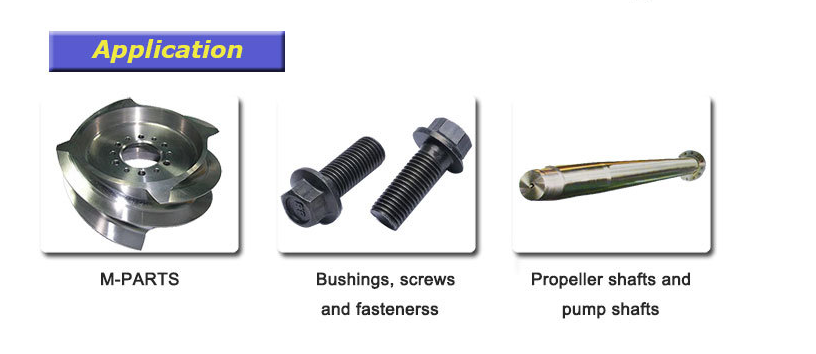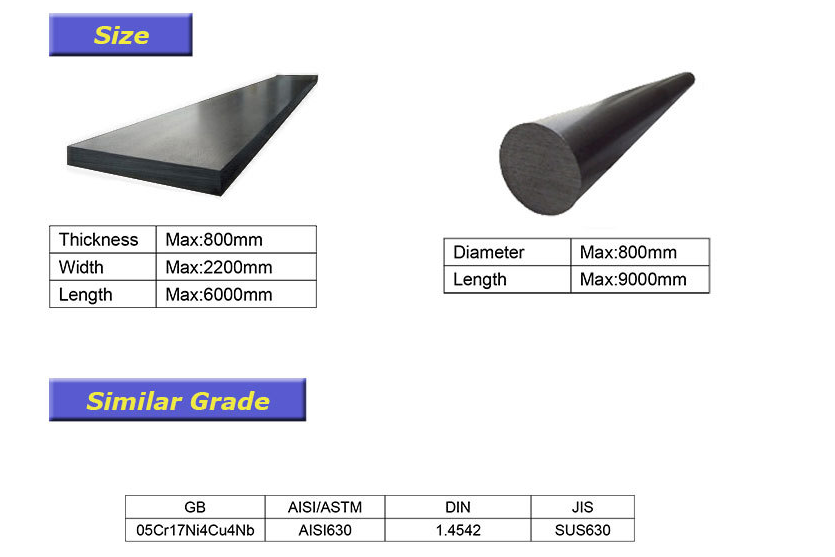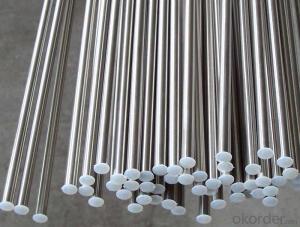okorder gold supplier en1.4301 stainless steel bar
- Loading Port:
- Tianjin
- Payment Terms:
- TT OR LC
- Min Order Qty:
- 100 kg
- Supply Capability:
- 1000 kg/month
OKorder Service Pledge
Quality Product, Order Online Tracking, Timely Delivery
OKorder Financial Service
Credit Rating, Credit Services, Credit Purchasing
You Might Also Like




- Q:What is the difference between 904L and 316L stainless steel pipes?
- The composition of 904L and 316L stainless steel pipes sets them apart. 904L contains higher amounts of chromium, nickel, and molybdenum compared to 316L. Specifically, 904L has about 25% nickel and 4.5% molybdenum, while 316L contains approximately 10-14% nickel and 2-3% molybdenum. In terms of corrosion resistance, 904L stainless steel pipes outperform 316L due to their higher chromium, nickel, and molybdenum content. The increased alloying elements make 904L more resistant to localized corrosion, such as pitting and crevice corrosion, particularly in aggressive environments like seawater and acidic conditions. When it comes to strength and toughness, 904L stainless steel pipes have the upper hand over 316L. This makes them more suitable for applications requiring greater mechanical properties, like high-pressure and high-temperature environments. In terms of cost, 904L stainless steel is generally pricier than 316L due to its higher alloying elements. The increased cost is mainly due to the higher nickel and molybdenum content, which are more expensive metals. 316L stainless steel pipes find common usage in various industries, such as food processing, chemical processing, and pharmaceuticals, where corrosion resistance and good mechanical properties are crucial. On the other hand, 904L stainless steel pipes are primarily utilized in highly corrosive environments like offshore platforms, petrochemical plants, and desalination plants, thanks to their exceptional corrosion resistance. In summary, the main distinctions between 904L and 316L stainless steel pipes lie in their composition, corrosion resistance, strength, cost, and applications. While 316L is suitable for general-purpose applications, 904L is preferred in more demanding and corrosive environments.
- Q:What is the difference between 304J1 and 316J1 stainless steel pipes?
- The main difference between 304J1 and 316J1 stainless steel pipes lies in their composition and properties. 304J1 stainless steel is a variant of 304 stainless steel, which contains a higher percentage of manganese to enhance its formability and reduce the risk of strain hardening during fabrication. This makes it more suitable for certain applications where deep drawing or severe bending is required. However, it is less corrosion-resistant compared to 316J1 stainless steel. On the other hand, 316J1 stainless steel is a variant of 316 stainless steel, which contains a higher percentage of nitrogen to improve its strength and corrosion resistance. It also has slightly better resistance to pitting and crevice corrosion in chloride environments. Therefore, 316J1 stainless steel pipes are often preferred in applications where higher corrosion resistance is required, such as marine environments or chemical processing plants. In summary, while both 304J1 and 316J1 stainless steel pipes are suitable for various applications, the choice between them depends on the specific needs of the project, including the level of corrosion resistance required and the fabrication processes involved.
- Q:What are the factors to consider when selecting stainless steel pipes for a specific application?
- When selecting stainless steel pipes for a specific application, there are several factors to consider. These include the required level of corrosion resistance, the temperature and pressure conditions the pipes will be subjected to, the desired strength and durability, the compatibility with other materials in the system, the cost-effectiveness, and any specific industry or regulatory requirements. Additionally, factors such as the pipe size, wall thickness, and configuration should also be taken into account to ensure the pipes meet the specific needs of the application.
- Q:304 stainless steel tube with the diameter of 25*2-3 is what mean
- This is according to the "water drawing standards" (GBT50106-2001) in 2.4.2-2 seamless steel pipe, welded steel pipe (straight or spiral seam), brass, stainless steel pipe, pipe diameter should be D diameter * thickness representation (such as D108 * 4 and D159 * 4.5); and the provisions of the habit of acting D with seamless pipe diameter.
- Q:What is the difference between double wall and single wall stainless steel pipes?
- When comparing double wall and single wall stainless steel pipes, their construction and applications are the key distinguishing factors. Single wall stainless steel pipes are composed of a single layer of stainless steel. They find common use in various industrial settings, including plumbing, heating, ventilation, and air conditioning systems. These pipes are renowned for their durability, resistance to corrosion, and high tensile strength. They are suitable for transporting fluids and gases at moderate temperatures and pressures. On the contrary, double wall stainless steel pipes consist of an inner and outer layer of stainless steel, with insulation sandwiched in between. The insulation layer provides thermal insulation, preventing the transfer of heat and maintaining the desired temperature of the fluid or gas within the pipe. Double wall stainless steel pipes are typically employed in applications where temperature control is crucial, such as high-temperature industrial processes or the transportation of hot or cold fluids. Due to the presence of insulation, double wall stainless steel pipes exhibit superior energy efficiency compared to single wall pipes. They reduce heat loss or gain, thereby minimizing energy consumption and optimizing the efficiency of heating or cooling systems. Furthermore, the insulation layer also aids in reducing condensation, which can prevent damage to surrounding equipment or structures. In conclusion, the main distinction between double wall and single wall stainless steel pipes lies in the inclusion of an insulation layer in double wall pipes. This insulation layer grants them thermal insulation, making them ideal for applications that necessitate temperature control and energy efficiency. Conversely, single wall pipes are commonly utilized in various industrial settings where insulation or stringent temperature control is not required.
- Q:Can stainless steel pipes be inspected for defects?
- Stainless steel pipes indeed undergo inspections to detect defects. Numerous methods and techniques exist for this purpose. A widely employed approach involves visual inspection, wherein well-trained inspectors visually examine the pipes' exterior surface to spot visible defects like cracks, corrosion, or dents. Apart from visual inspection, non-destructive testing (NDT) methods also prove useful for inspecting stainless steel pipes. NDT techniques like ultrasonic testing, radiographic testing, magnetic particle testing, and dye penetrant testing effectively identify internal defects such as cracks, weld flaws, or any other discontinuities that might jeopardize the pipe's integrity. These inspection methods guarantee that stainless steel pipes meet the necessary quality standards and specifications. By promptly detecting defects, appropriate actions can be taken to rectify or replace faulty pipes, thus ensuring a secure and reliable performance in various applications like plumbing, oil and gas pipelines, and industrial processes.
- Q:What are the different types of stainless steel pipe bends?
- There are several different types of stainless steel pipe bends, including 45-degree, 90-degree, and 180-degree bends. Additionally, there are short radius and long radius bends, as well as U-bends and J-bends. These variations allow for flexibility in designing and connecting stainless steel piping systems to fit specific needs and spatial constraints.
- Q:What is the difference between 17-4 and 316 stainless steel pipes?
- The main difference between 17-4 and 316 stainless steel pipes lies in their composition and properties. 17-4 stainless steel, also known as SAE type 630, is a precipitation-hardening stainless steel that contains approximately 17% chromium and 4% nickel. It also contains small amounts of copper, niobium, and tantalum. The addition of these elements enables 17-4 stainless steel to undergo a heat treatment process, known as precipitation hardening, which increases its strength and hardness. This makes it suitable for applications that require high strength and good corrosion resistance, such as in aerospace and defense industries. However, it may not have the best resistance to certain corrosive environments compared to other stainless steels. On the other hand, 316 stainless steel is an austenitic stainless steel that contains approximately 16-18% chromium, 10-14% nickel, and 2-3% molybdenum. This composition provides excellent corrosion resistance, particularly in chloride-containing environments such as marine environments or coastal areas. 316 stainless steel is also known for its good weldability and formability, making it a popular choice in various industries including food processing, pharmaceuticals, and chemical processing. In summary, the primary difference between 17-4 and 316 stainless steel pipes lies in their composition and properties. 17-4 stainless steel offers higher strength and hardness through precipitation hardening, while 316 stainless steel provides superior corrosion resistance, especially in chloride-containing environments. The choice between the two will depend on the specific requirements of the application, with considerations for strength, corrosion resistance, and other factors.
- Q:What is the difference between seamless and seamless redrawn stainless steel pipes?
- The main difference between seamless and seamless redrawn stainless steel pipes lies in their manufacturing processes. Seamless stainless steel pipes are produced from solid billets without any seams or welded joints, resulting in a smooth and continuous pipe. On the other hand, seamless redrawn stainless steel pipes are initially produced through the seamless process, but then they undergo additional drawing or resizing processes to achieve more precise dimensions, smoothness, and improved surface finish. Overall, seamless redrawn stainless steel pipes offer enhanced precision and surface quality compared to standard seamless pipes.
- Q:Can stainless steel pipes be used in nuclear power plants?
- Yes, stainless steel pipes can be used in nuclear power plants. Stainless steel is a commonly used material in the construction of nuclear power plants due to its high strength, corrosion resistance, and ability to withstand high temperatures. Stainless steel pipes are particularly suitable for carrying coolant, gases, and other fluids within the power plant. These pipes are able to handle the demanding conditions and requirements of a nuclear power plant, including the high pressure and high temperatures that are present in certain parts of the plant. Additionally, stainless steel is resistant to the corrosive effects of radiation, making it a reliable choice for use in nuclear power plants.
1. Manufacturer Overview |
|
|---|---|
| Location | |
| Year Established | |
| Annual Output Value | |
| Main Markets | |
| Company Certifications | |
2. Manufacturer Certificates |
|
|---|---|
| a) Certification Name | |
| Range | |
| Reference | |
| Validity Period | |
3. Manufacturer Capability |
|
|---|---|
| a)Trade Capacity | |
| Nearest Port | |
| Export Percentage | |
| No.of Employees in Trade Department | |
| Language Spoken: | |
| b)Factory Information | |
| Factory Size: | |
| No. of Production Lines | |
| Contract Manufacturing | |
| Product Price Range | |
Send your message to us
okorder gold supplier en1.4301 stainless steel bar
- Loading Port:
- Tianjin
- Payment Terms:
- TT OR LC
- Min Order Qty:
- 100 kg
- Supply Capability:
- 1000 kg/month
OKorder Service Pledge
Quality Product, Order Online Tracking, Timely Delivery
OKorder Financial Service
Credit Rating, Credit Services, Credit Purchasing
Similar products
New products
Hot products
Hot Searches
Related keywords


























